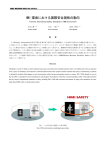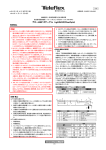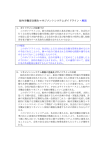Download 第53号
Transcript
Association of Sophian Teachers of English 上 智 大 学 英 語 教 員 研 究 会 第53号 2005年9月15日 A Comparison of the English Proficiencies of Japanese (SELHi vs. Non-SELHi), Korean, and Chinese High School Students 第 134 回例会 2005 年 4 月 23 日 吉田研作 (上智大学) Preface The survey on which this paper is based was conducted in 2004 in Japan, Korea, and China in collaboration with Benesse Corporation, and the construction of the survey items and analyses were conducted by the present author in collaboration with Negishi (Tokyo University of Foreign Studies), Watanabe (Akita University), Naganuma (Seisen Womens University), Kwon (Seoul National University), and Tei (Beijing Teachers’ College). There were overall more than 10,000 students surveyed, along with the teachers teaching at the respective high schools. In order to be as accurate as possible in comparing the results of the students’ test1 and survey 2 results, only academically high level (college-bound) high schools were selected for the three-nation comparison, along with Ministry of Education, Culture, Sports, Science and Technology-(hereafter, Ministry of Education) funded Super English Language High Schools (SELHi’s), where special emphasis is placed on conducting innovative and communicative English classes. The aims of the survey were threefold: 1) to compare the test and survey results of students in the three countries and see what similarities and or differences might exist; 2) to compare the way teachers teach in these three countries and see if the their teaching has any effect on the students’ development of their English proficiency3; 3) to compare the students’ English proficiency levels and the way teachers teach in the Japanese regular high schools versus the SELHi’s. Benesse Corporation’s G-TEC for Students, which is an English proficiency test specifically made for high school students, was used. 2 A CAN-DO questionnaire and students’ perception of teachers’ teaching practice questionnaire were administered. (cf. 東アジア高校英語教育GTEC調査―高校生の意識と行動から見る英語教育 の成果と課題, Benesse Corporation, 2005) 3 Research Results from the previous year were also referred to. (cf. 東アジア高校英語教育調査 −指導と成果の検証、Benesse Corporation, 2004) 1 1 Introduction The Japanese Ministry of Education in recent years has taken a number of steps to reform English education in Japan through its ‘Action Plans’ to cultivate Japanese with English abilities (cf. retrieved Sept. 8, 2005 from http://www.mext.go.jp/english/topics/03072801.htm). As a part of the Action Plan, the Ministry proposed a survey of the English education policies of other countries as a means for promoting discussions about concrete ways to reform English education in Japan. The present research was designed to go one step further by actually comparing the English proficiencies of high school students in Japan, Korea, and China, and to see what differences there might be in the students’ perceptions of their own English abilities, as well as the way their teachers teach. The institution of Super English Language High Schools (SELHi) is also one of the Ministry’s major projects (cf. retrieved Sept. 8, 2005 from http://www.mext.go.jp/b_menu/houdou/17/04/05040502.htm). In the 2005 academic year, 101 high schools around the nation have been designated as Super English Language High Schools, and in March, 2005, the first 16 SELHi projects concluded after three years of experimentation with innovative, communicative ways of teaching English. In this paper, I will also refer to the results of these projects and compare them with the results of more traditional English education as evidenced in the regular, albeit academically high level, high schools in our three-nation comparative research. Approach, Design and Procedure Richards & Rodgers (2001) note an important distinction between Methods and Approaches. Very often, I hear teachers talk about methods and approaches as if they were the same. People have asked me how to teach the Communicative Approach. However, an approach is not the same as a method. Whereas a method is like a pre-packaged, step-by-step way of teaching a language, an approach constitutes the basic principle of language learning which underlies the method. In other words, a method is developed on the basis of a ‘theory’ of how languages are learned, and this ‘theory’ constitutes the approach. For example, years ago, it was commonly assumed that the learning of the structure (or grammar) of a language was equal to the learning of the language itself. Once a learner had acquired the structure of the language and was able to use it freely, the language was assumed to have been acquired. The grammar-translation methods as well as the audiolingual methods were developed on the basis of this theory. Therefore, the Design, or the curriculum and syllabus, used were based on the so-called structural, or grammatical syllabus, and the Procedure, or actual techniques of teaching, consisted of grammar exercises, translation exercises (in the case of the grammar-translation methods) and mimicry-memorization and pattern practice (in the case of the audiolingual methods). There was very little room for ‘actual use of the language’ in authentic interaction and communication settings. However, in the last twenty-five years or so, the teaching of second and foreign languages have centered on the so-called Communicative Approach. Here, the basic ‘theory’ is based, not simply on knowledge and use of grammatical structures, but on a more comprehensive ‘communicative competence,’ as seen in the works of Canale and Swain (1980), Savignon (1997) and others, or ‘language ability’ as seen in the works of Bachman (1990), Bachman & Palmer (1996), McNamara (1996) and others. According to this approach, learning a language is considered equal to acquiring the ability to use it in real-life communication settings. Not only the knowledge of the structure of the language, but all four 2 competences—grammatical competence, discourse competence, sociolinguistic competence and strategic competence—as noted by Canale, Swain, and Savignon (further elaboration of the concepts have been made in Bachman, Bachman and Palmer, and McNamara’s works) must all be acquired in order to say that someone has ‘acquired’ the language. Simply knowing the structure of single sentences does not guarantee success in using the language in real situations. L2 users must be able to express their ideas and feelings in discourse frameworks (both spoken and written). They must be able to use language appropriately in social situations, and they must be able to put their ideas into language in the most effective manner, and to negotiate for meaning whenever communication breaks down. The Design, therefore, must be based on a combination of, for example, situational, notional-functional, and procedural syllabuses. The Procedures will comprise (pseudo-)authentic communication tasks, speeches, discussions, debates, simulations, as well as actual writing of letters, reports, etc. The teacher will be required to provide as much opportunity for the students to ‘use’ language meaningfully as possible. Teachers’ beliefs and teaching practice—classroom activities In order to see what approach teachers follow in their teaching, and to see how much of their beliefs are reflected in their actual teaching, we asked high school teachers to mark on a Lickert scale of 1 to 5, how important they thought the statements in table 1 were as aims (beliefs), and how much they were actually putting them into practice. The results show that, overall, teachers’ aims and beliefs about English education are quite communicative. (figure 1, bars on the left). However, when it comes to practice, teachers are not really practicing what they deem to be important in English education (figure 1, bars on the right). To be more specific, for statements B21, B30 and B33—all of which are communicative activities—the difference between beliefs and practice are quite large, whereas, for statements 47 and 48—which are structure-based activities—there is very little difference between the teachers’ beliefs and practice. In fact, especially in the case of the regular Japanese high school teacher, the level of practice is higher than the beliefs for statements B47 and B48. In other words, they seem to be doing more structure and vocabulary-based activities than they themselves believe is necessary. B21 聞いた内容に対して、内容や自分の考えなどについて、英語で話し合ったり意見の交換をさせたりす る。(exchange ideas, opinions) B30 身近な話題について、自分や聞き手の置かれた状況を考慮し、伝える目的を考えながら英語で情報を 伝えたり、会話をさせる。(goal-oriented speaking, interaction) B33 ペアワークやグループワークを用いて、生徒間で実際に英語を使ったコミュニケーションを行えるよ うなタスク(課題)を行わせる。(pair work, group work in English) B47 語句や文型・文法の解説をする。(explaining structures, vocabulary) B48 英文和訳をさせる。(English to Japanese translation) Table 1. Selected statements about teachers’ beliefs and practice It is interesting to note that of the three countries, Chinese teachers answer that they are practicing their 3 beliefs to a very high degree, in both communicative and structural activities, whereas the Japanese teachers in regular schools show the largest gap between their beliefs and practice in the communicative activities. Another point to note, however, is that the Japanese SELHi teachers seem to be practicing their beliefs to a greater extent than either the Japanese teachers in the regular schools or Korean teachers. The SELHi teachers also rank the lowest in the use of translation in their classes. 5 .0 0 4 .0 0 理念 実践 3 .0 0 2 .0 0 B4 8 B4 8 B4 8 B4 8 B4 7 B4 7 B4 7 B4 7 B3 3 B3 3 B3 3 B3 3 B3 0 B3 0 B3 0 B3 0 B2 1 B2 1 B2 1 B2 1 1 .0 0 日本韓国中国 S ELHi 日本韓国中国 S EL Hi 日本韓国中国 S ELHi 日本韓国中国 S ELHi 日本韓国中国 S ELHi Figure 1. Average ratings of teachers’ beliefs and practice (from left to right in each statement, Japan (regular), Korea, China, SELHi) As can be seen from figure 1 above, the Chinese and SELHi teachers seem to be doing more communicative activities than the regular Japanese high school teachers or the Korean teachers. In order to see if the teachers’ responses are reflected in the way the students perceive the way they are being taught, the same questions were asked of the students studying in these respective schools. A factor analysis showed that the answers to the statements could be divided into four factors. 4 F1 ・読んだ/ 聞いた内容に対して、内容や自分の考えについて、英語で話し合っ たり意見の交換を したりする ・読んだ/ 聞いた内容に、概要や要点、自分の考えなどをまとめて英語で書く ・自分が考えていることなどについての考えをまとめ、簡単なスピーチ等の発表を行う (Cognitive) F2 ・文章の中でポイントとなる語句や文、段落の構成や展開などに注意して読む ・英文和訳する ・語句や文型・文法の解説を聞く ・文法や語法について正しく書くことに留意して書く (Grammar/Translation/Vocabulary) F3 ・教室内の指示などが英語で行われている ・ペアワークやグループワークで、実際に英語を使ったコミュニケーション活動を行う (Oral/ Interactive) Figure 2. Statements grouped as the result of factor analysis Factor 1 consists of statements in which the common factor is that the teachers are making the students think and produce English; factor 2 shows statements related to the teaching of the forms of English; factor 3 consists of statements concerning the use of interactive communicative English in class; and factor 4 is a meaning-based activity, although Japanese (native language) is used in the summarizing process. From figure 3 it can be seen that whereas the regular Japanese high school students feel very strongly that they are being taught the forms of the language, the SELHi students feel that they are getting a balanced regimen of meaningful, cognitive activities, use of interactive communicative English, as well as knowledge of the forms of English. 70 60 58 50 47 45 Japan regular 日本(一般校) 42 39 40 韓国 Korean 中国 Chinese 34 30 日本(SEL Hi) SELHi 28 20 19 15 14 10 23 21 19 17 9 8 0 F1 F2 F3 F4 Figure 3. Students’ perceptions of how teachers teach 5 Teachers’ beliefs and teaching practice—real world activities In teaching English for the purpose of communication, it is not enough to simply examine classroom activities. The real purpose of teaching a language for communication is in getting the students to use the language for communicative purposes in the ‘real world.’ In other words, even if the students in China and SELHi’s are getting an abundant experience in using English for communication in the classroom, unless this ability can be used in the real world (Open Seas)4, it cannot be said to be truly effective in producing true ‘L2 users.’ We, therefore, administered a CAN-DO questionnaire which includes statements about what real world activities teachers are employing in their teaching, and students believe they can actually perform. Table 2 shows the statements which were used for this survey. B51 英語での電話 (Telephoning) B52 自分の好きな洋楽アーティスト(歌手、音楽グループ)の英語の歌 (Singing) B53 英語で書かれたインターネットのホームページ (Home Page) B54 教科書以外で、自分から進んで読む英語の本や雑誌・新聞 (Books, Newspapers, etc) B55 英語で書かれたレシピや説明書(例えば、電気製品などの取扱説明書や薬の飲み方) (Reading directions) B56 テレビ・ラジオでの英語音声のニュース・天気予報 (TV and radio news, weather) B57 英語音声の映画・ビデオ・DVD (Movies) B58 英語で書く日記 (Writing diaries) B59 英語で書く電子メールやカード・手紙 (E-mail, letters) B60 ホテルや駅の窓口、インフォメーション・センターなどでの英語のやりとり (Information) B61 買い物やファストフード・レストランでの注文(Shopping) B62 街の掲示や案内 (Ads, directions) B63 公共の乗り物やガイドツアーのアナウンス(Announcements) B64 道を聞かれて答えたり、友だちを遊びや旅行などに誘う時などの時間や場所などの説明(Instructions) B65 ホームステイ先や寮などで食べ物の好みや約束事などについて自分の希望を伝える(Conveying wishes) Table 2. Statements about ‘real world’ activities The results of selected statements show (Figure 4) that Korean, Chinese, and SELHi teachers are including real world activities in their teaching to a relatively high degree, whereas, again, the regular Japanese high school teachers are not doing it very much. cf. Yoshida (2002) for a discussion on the Fish Bowl Model versus the Open Seas Model of teaching foreign languages. 4 6 5.00 4.00 3.00 理念 実践 2.00 B57 B 58 B 60 B 64 Figure 4. Use of ‘real world’ activities in the classroom. (from left to right in each statement, Japan (regular), Korea, China, SELHi) We next looked at the results of the students’ perceptions of how much English they think they can actually use in the real world (CAN-DO). The results, again, show that Korean, Chinese, and SELHi students have more ‘confidence’ in using English for real world communication purposes than the regular Japanese high school students. (Figure 5) Of course, whether the differences seen between the regular Japanese high school students and the SELHi students are the result of the differences in teaching practice, or the result of other internal factors—such as motivation—needs to be clarified. However, considering the fact that many of the SELHi’s were normal public high schools before being designated as SELHi’s, the result could very well have come from the changes which accompanied the designation as a SELHi. 7 SELHi 中国 韓国 日本 中国 SELHi 韓国 日本 中国 SELHi 韓国 日本 SELHi 中国 韓国 日本 中国 B 56 SELHi 韓国 日本 中国 B 54 SELHi 韓国 日本 1.00 4 日本 韓国 中国 S EL H i 3 2 1 B51 B52 B53 B54 B55 B56 B57 B58 B59 B60 B61 B62 B63 B64 B65 Figure 5. CAN-DO results of students in the four groups (from left to right in each statement, Japan (regular), Korea, China, SELHi) Differences reflected in GTEC scores. As can be seen from the data above, there are consistent differences between the regular Japanese high schools and the Korean, Chinese, and the Japanese SELHi’s in terms of teaching practice and student perceptions of their confidence in using English. In order to verify whether or not these differences are reflected in objective test scores, Benesse Corporation’s GTEC for Students (General Test of English Communication for Students) was administered to all 10,000 students. As the results show (Figure 6), the effects of communicative teaching, with emphasis on communication and ‘thinking’ activities, can clearly be seen in the results of the GTEC scores when compared with the score of the Japanese national average (based on approximately 200,000 high school students). Although the regular Japanese high school students in the present research received significantly higher scores than the national average because they were students studying in academically high level, competitive schools, they did not come close to those of the Chinese and Japanese SELHi students. The differences seen in the teaching of English in these schools have been shown consistently throughout this paper—communicative teaching produces students with more confidence in using English in real-life situations, and this is reflected in the results of objective English proficiency tests. 8 3国平均とSELHi 600 555.8 550 503.6 500 450 438.2 430.9 400 400 408.6 461.8 440 435.9 405 428 日本の平均 371 日本3国比較(受験校) 350 韓国 中国 SELHi校平均 300 1年 2年 3年 Figure 6. Differences in GTEC scores (same students tested the past 2 a/o 3 years) ( =Japanese Narional Average, ■= Regular Japanese schools (present research), ▲=Korean schools, ×Chinese schools, *SELHi’s) Conclusion The results of our survey allow us to surmise that teaching practice can have a significant effect on the development of the English proficiency of the students. It has been shown that the Approach adhered to by English teachers in the regular Japanese high schools is not reflected in their teaching, whereas, in the case of the Chinese and SELHi teachers, their Approach is reflected to a great degree in their teaching. Another interesting finding is that, although it is often assumed that Japanese students fall behind their Korean and Chinese counterparts in English proficiency, the SELHi students are actually doing better than their counterparts as measured by the GTEC. The SELHi students’ confidence in using English in real world contexts does not differ as much from those of the Chinese and Korean counterparts either. It is the students studying in the more traditional regular Japanese high schools who register lower test scores and show a weaker confidence in using English. The Ministry of Education’s initiatives in reforming English education is bearing fruit, at least in the SELHi’s. There is still much that must be done to truly reform English education in Japan. However, it is my belief that the first steps have been taken in the right direction. References Bachman, L. (1990) Fundamental Considerations in Language Testing. Oxford University Press Bachman, L. and A. Palmer (1996) Language Testing in Practice. Oxford University Press Canale, M. and M. Swain (1980), Theoretical bases of communicative approaches to second language teaching and testing. Applied Linguistics 1:1-47 McNamara, T.F. (1996) Measuring Second Language Performance. London and NewYork: Longman Richards, J. & T. Rodgers (2001) Approaches and Methods in Language Teaching, a Description and Analysis, 9 Second Edition. New York: Cambridge Savignon, S.J., (1997) Communicative Competence: Theory and Classroom Practice, Second Edition. New York, NY: McGrawHill Yoshida, K. (2002) Fish Bowl, Open Seas and the Teaching of English in Japan, in Baker (ed) Language Policy: Lessons from Global Models, Monterey: Monterey Institute, pp.194-205 「東アジア高校英語教育調査−指導と成果の検証」 (2004)Benesse Corporation 「東アジア高校英語教育 GTEC 調査―高校生の意識と行動から見る英語教育の成果と課題」 (2005) Benesse Corporation 教育実習を終えて(1) 第135回例会 2005年5月21日 高田真希子 (上智大学) 私は県立高校で、3 週間の実習を行いました。私の日程は、授業見学 2 日、文化祭関係 5 日、授 業 8 日(計 17 回程)でした。また、指導教員はとても穏やかで、自由にやらせてくださいました。(こ れは本当に個人差があります。細かい支持を受ける人も多いです。) 教育実習の中で、私が一番大切だと思ったことは、名前を覚えることです。行く前は、覚える必 要はないと思っていたのですが、ホームクラスの名前だけは集合写真とその名簿を借りて覚えてい きました。実際にやってみると、ホームクラスと他のクラスでは授業のやりやすさ、生徒との距離 感が全く違いました。 名簿を見ながら顔と名前が一致しないまま指名すると本当にやりにくいです。 実習の最終日に、何気なく全員の名前を覚えているということを生徒に伝えたら、何人も「私の名 前は?」 「俺の名前は?」と私のところに確認しに来ました。自分にしっかり目が向けられていると いうことを感じられるのが生徒にとって大切なのだなと思った瞬間でした。 授業の準備は、実習開始 3 日前の説明会で教科書を受け取り、プリントを作ったり大まかな流れ を考えたりしたので、比較的遅かったかもしれません。ただ、現場の感じをつかむには良かったと 思います。先生方は他の仕事もあるのでじっくり準備期間を与えられないということが、同じよう な状況に自分を置いてみてよくわかりました。ただ、他の実習生には、もっと時間を取らないと無 理で、準備の為にいつも 3 時間前後しか眠れなかったと言う人もいます。自分にとって「これで明 日授業ができる」という状態になるまでやることが大切だと思うので、かかる時間や効率の良し悪 しには個人差が出ると思います。生徒のための予習プリントは、間違いがあってはいけないという こともあり、意外に考えないといけないことが多いです。授業のプランは、毎回進度によって変わ るので、ほぼ前日に考えることが多かったです。最初のうちは、あまりに授業の途中でチャイムが 鳴る事ばかりだったので、時間配分の目安を項目ごとに書いたりもしました。これは、囚われすぎ ずにやることができれば、書いておくと便利だと思います。 授業では、始める前に 1 分ぐらいは英語を話すようにしましたが、これはかなり文章を練って中 学生レベルの単語だけで話すか、もしくは確認の為おおまかに内容を言ってあげる必要がありまし た。話しながら全員とアイコンタクトをするように心がけるといいと思います。英語で授業をした 10 かったのですが、読解ということもあり、日本語が多かったです。ただ、音読やリスニングをさせ たりして、 なるべく英語に触れられるようにしました。 クラスによって進度も理解度も違ったので、 ぶつけ本番というか、生徒にその場で好きな言葉を言ってもらって、そこからいろいろな例文を作 っていって、生徒と一緒に授業を作っていく感じで、うまくいった時は最高でした。盛り上がりの ないクラスでは自分もテンションを上げられなかったのですが、盛り上がりがないだけで皆ちゃん と授業を聞いていたし、支持してくれていた子が多かったことを最後に取ったアンケートで知り、 ちょっと驚いたりもしました。だから、自分のテンションというか、皆を巻き込んでいこうと言う 気持ちを強く持って、盛り上がりがなくても負けないことが大切だと思います。また、とっさに例 文を出そうとすると、文法があっているかどうか不安になったりもします。でも、そういうことよ りも私は生徒が出した意見を生かすように文を作って授業を進めようということに重点を置きまし た。文法は本に載っているけれど、生徒が使いたいと思うような文章は生徒の中にしかなく、それ を引き出して使ってみせたかったのです。だから、構造を覚えてくれればいいという例文の中には 日本語も混ざっていました。“Students in 1-9” など、読み上げるときは「Students in 一の九」と読 み上げたり、 「もやし」と言われてとっさに単語が出なくて、ローマ字でつづったり、生徒はかなり の子が辞書を持っていますので、 必要なときは自分で引いて調べてもらっていいかなという感じで、 自分の語彙力だけで対応する事はやめておきました。英語が苦手な生徒にも「やってみよう」と言 う気持ちを持ってほしかったので辞書を引いて正確につづってというよりは日本語になる部分があ ってもいいから辞書なしでもやってみようと思えるように、あえて自分は完璧でいようという考え を捨てたと思います。声に関してですが、うがいをするなど、喉を大切にしてください。私も最後 の一週間とても辛く、他の実習生は声が出なくなった人もいました。また、板書は机間巡視の際に 後ろまで行ったときに自分で見てみるといいと思います。大きさやバランスがよくわかります。 最後に、私は受け入れられないのではないかという不安で 1 週間ぐらいは自分が心を閉ざしてし まっていたので、もっと心を開ければよかったと思います。生徒の側も、よく見ているとわかりま すが、文化祭の準備などで溶け込めないでいる子や退屈している子がいます。私はそういう子から 段々に話しかけていきました。 「みんな、∼してください」というだけでなく、一人ひとりにも折を 見て働きかけていくことでクラス全体の反応や空気も少し変わると思います。みんな、相手が応え てくれるかどうか、不安は持っているから、先生の方が心を開いて話しかけて関係を築いていくよ うに心がけるといいと思います。 教育実習を終えて(2) 古川瑛子 (上智大学) 私は 5 月 23 日から 6 月 11 日の 3 週間、母校である桐朋女子中・高等学校で教育実習を行った。 高校 2 年の標準と発展の英語クラスと、高校 2 年E組のホームルームを担当した。毎日が学びの連 続で、ぎゅっと密度の濃い実習期間であった。授業観察、教壇実習、そしてHR指導を通じて、印 象深い点を振り返りたい。 実習開始後の一週間と、担当授業のない時間は、ほぼすべて授業観察に費やした。担当の先生の 勧めにより、 英語の授業を中学一年から高校三年まで通して観察し、 日本の学校で英語を学ぶ流れ、 11 そして学校が目指す英語教育のあり方を学ぶことができた。この経験は、自分が担当する学年と学 習内容が中高 6 年間の学習カリキュラムの中でどこに位置しているのかを認識し、それを生かした 指導案作成に役立った。また英語に限らず様々な科目の授業観察を通じて、それぞれの科目が持つ 教授法の特徴を知った。中でも英語は特に生徒参加型の科目であると感じた。無論、すべての授業 は生徒・教師間の相互作用で成立する。しかし、社会・国語が一般的に教師から生徒へ一方通行の 講義中心教授法を取り、また家庭科や保健体育が実践中心型教授法を取るのに対し、英語は講義形 式に加え、発音や音読、アクティビティーなど生徒が頻繁に授業に参加するスタイルの科目である ことを実感した。さらに、同じ実習生の授業観察は、自らを振り返る貴重かつ刺激的な機会であっ た。板書の文字の大きさや指示のあいまいさ、ふとした癖から出る言葉の重みなど、生徒の視点か ら気づく点は多く、それはまさに教壇実習を行う自分自身の鏡であった。 2 週間行った教壇実習では、特に文法の教え方に頭を悩ませた。帰国子女ゆえに感覚で英語を習 得した私にとって、どのように文法を教えることが彼女たちにとって理解しやすいのか、分からな かった。単なる文法書の暗記で片付けたくはなかったが、時間的制限もあり最終的には比較的オー ソドックスな板書形式で解説した。しかし、説明プリントを作成し、できるだけ身近な内容の例文 を並べることで、彼女たちが日常生活とリンクできるよう工夫した。また、今回の教育実習を大学 で学んできた英語科教育法の実践するチャンスととらえ、英語のみの授業を試みた。インプットの 英語を、日本語を介して理解するのではなく、英語のまま頭に入り理解できるように、という目標 のもと、英語に触れる量を増やし、英語に慣れよう、との指導方針を立てた。当初はクラスルーム・ イングリッシュのみならず授業内の指示すべてを英語で行った。しかし、標準クラスの生徒は、さ っぱりわからない、とあきらめを感じる唖然とした顔つきであった。発展クラスでは、生徒によっ て差はあるものの全体的に少しは理解ができ、 なんとか耳を傾け着いていこうとする意欲を感じた。 その後は、英語の指示後日本語で言い直すスタイルをとり、日本語の量を生徒のレベルに応じて調 整した。生徒にとって、どこまでがやる気をかき立てる「挑戦レベル」で、どこまでがやる気を失 う「お手上げレベル」であるのか、その線引きは非常に難しく感じた。もちろん、英語レベルは生 徒一人一人異なるが、クラスとしてその線の位置を判断するのは簡単ではなかった。 また、ホームルーム指導では朝のホームルームや学年の時間、放課後の掃除などを通じて生徒た ちと交流することができた。私のクラスでは毎週 2 回、趣味や最近考えていることなどについて一 人 5 分間クラスに話す「語り」の時間があり、スピーカーに対しては全員がコメントを書く仕組みで あった。私のクラスはまとまりがあり、暖かい雰囲気を持っているように感じたが、それもお互い を知り、よい語り手、そして聞き手になる「語り」企画によるものなのかもしれない。加えて、実習 期間中に体育祭が開催されため、普段とは違った生徒の様子を知ることができた。行事に並ならぬ 闘志を燃やす桐朋生にとって体育祭は文化祭と並ぶ学内 2 大イベントであり、高校二年生となって は優勝の可能性も遠くない時期である。この体育祭における生徒の活躍ぶりは、授業やホームルー ムとはまた違ったものであり、教室内だけで生徒を評価することはできないことを実感した。同時 に、体育祭における教師の細かなサポート体制にも脱帽した。表向きには生徒会や委員会など生徒 主体の行事に見える体育祭である。しかし、生徒が主役、の根本には先生の綿密な役割分担とスケ ジュール管理の徹底が不可欠なのである。生徒であった以前はまったく気づかなかった教師の動き を、実習生として始めて認識した。このような、教科指導だけでない多岐に渡る教師の持つ役割に 驚いた。 実習生は 3 週間という期間限定の先生であるが、教師は毎日生徒の前に立つ。教育実習は生徒の 12 成長を感じる喜び、多感な中高生を教える難しさなど、職業としての教師のやりがいや苦労の一部 を身を持って感じるかけがえのない経験であった。最後に、事前指導で様々なアドバイスをいただ き、お世話になった現場の先生方に感謝します。 ネゴシエーションの中でのフィードバックの効果 ―英語学習者が二人の対話者から得た矯正的フィードバックの習得率の検証― ASTE 第 136 回例会 2005 年 6 月 18 日 金子 義隆 (育英短期大学) 言語学習におけるネゴシエーションの効果は近年多くの研究者の関心を集めてきた。それによっ てネゴシエーションのメカニズムが明らかになってきた。中でもネゴシエーション中に受けるフィ ードバックは重要な働きをしているようである。 この研究は、 そのフィードバックに関するもので、 特に矯正的フィードバックがもたらす効果について実験し、分析したものである。 言語学習におけるネゴシエーションとは「聞き手がメッセージの意味を正確に理解するために話 し手に意味を明確にしてもらったり、確認したり、話し手はそれに応えて最初のメッセージを繰り 返したり、付け加えて説明したり、簡略化したりして、意思疎通を図るプロセス」 (Pica、1994 年)である。例えば次のようなものである。 例1: NS: and I have a garage on the side with three little black windows NNS: three black windows? NS: you know what a garage is? NNS: No. NS: um, it’s attached to the house. It’s a building attached to the house in which you keep your cars and called a garage, OK, so it looks like a big house and a little house, but they’re attached NNS: Oh, it’s a small house. NS: Uh-huh NNS: Uh-huh, and black roof? NS: Uh-huh NNS: Yeah, oh, maybe, let’s see, yeah, I understand. ( Pica, 1994 年, p. 511 に引用されていた Pica, Young, & 1992a, を引用) 上の例でNNSは最初「garage」という単語を知らなかったのが、NSがその単語の意味を分かり やすく説明してくれた一連のやり取りにより理解できたのである。その一連のやり取りがネゴシエ ーションと呼ぶものである。 上に例に挙げたのが成功したネゴシエーションであるが、必ずいつもそのやり取りが成功に終わ るわけではない。言語学習において理想的なネゴシエーションにはいつくかの構成要素が備わって 13 いなければならない。それは、メッセージ理解と目標言語のアウトプット、精選された注意力、肯 定的証拠、そして否定的証拠の5つあると考えられる。 まず、一つ目のメッセージ理解であるが、Krashen(1985 年)が主張するように英語のメッセージを 浴びるだけでは英語力向上にはつながらない。メッセージがどんな意味なのか理解する必要がある と考えられる。ネゴシエーションは意味のわからなかったメッセージを意味のわかるものにする (Long, 1981 年, 1996 年; Pica, 1994 年) 。 例2: NS: There’s there’s a pair of reading glasses above the plant. NNS: A what? NS: Glasses reading glasses to see the newspaper? NNS: Glassi? NS: You wear them to see with, if you can’t see. Reading glasses. NNS: Ahh ahh glasses to read you say reading glasses. NS: Yeah. (Mackey, 1999 年, pp.558-559) 例 2 が示しているように、NNSは初め理解できなかった「reading glasses」をNSとのネゴシエー ションを通してできるようになったのである。 二つ目は目標言語(この研究では英語)のアウトプットである。第二言語学習者は、第二言語に 対する仮説を自ら試し、新しい構文や表現を実験し、自身の中間言語力を創造的に向上させるため にアウトプットをする機会を持つ必要がある(Pica, Holliday, Lewis, & Morgenthaler、1989 年)。ア ウトプットは、単に意味が理解できるというステージから、正確な発言ができるためにより完成さ れた文法処理のできるステージに学習者を進めてくれる(Swain, 1995)。 三つ目は精選された注意力である。 「精選された注意力なしに、 学習者の文法力の向上は望めない。 つまり、文法力の向上の最初のステップは、自分のアウトプットとインプットのミスマッチに気づ くことである。 」と Gass と Selinker(1994 年)は主張している(p.307)。 (ネゴシエーションを含む) 対話の中で学習者は目標とする表現と自分が使っている表現との違いに注意を向けることができる のである(Long, 1996)。次に挙げる例は、ある二人の学生が英語話者にインタビューする課題に取 り組んでいるものである。二人の学生のある特定の発言だけを取り上げた。この課題の間に二人で 英語の表現を教えあったり、第三者に教えてもらうことはなかった。 例3: 1. Ana: Can you tell me where is the train station? 2. Keiko: Can you tell me where the train station is? 3. Ana: 4. Keiko: Can you tell me where the train station is? 5. Ana: 6. Keiko: Can you tell me where the train station is? 7. Ana: 8. Keiko: Can you tell me where the train station is? 9. Ana: Can you tell me where is the train station? Can you tell me where is the train station? Can you tell me where the train station is? Can you tell me where the train station is? (Gass & Varonis, 1994 年, p. 289 ) 14 上の例で分かるように、初めの頃、Ana は正確な表現を使えていなかった。しかし、課題に取り組 んでいるうちに自分の表現と Keiko の表現の違いに気づいたようだ。更には、それによって自分で 間違いを正し、最終的に正確な表現を自分で学んだようだ。 四つ目は、肯定的証拠である。肯定的証拠とは、 「 (目標言語の中で)文法的に正しく、受け入れ られるもののモデル」 (Long,1996 年,p.413)のことである。例2の中では、Keiko の表現がそう である。 最後の五つ目が否定的証拠である。否定的証拠とは、何が文法的に正しくなく、使われないかの 情報のことである。否定的証拠は言語学習において重要な要素だとされている。White(1991 年) の研究では、英語の副詞の正しい位置をフランス語話者に習得させるために2種類の教授法(肯定 的証拠のみと肯定的証拠と否定的証拠の両方)を使い、比較した。その結果、後者が統計的に見て も優位であることが分かった。 (しかし、長期的にはその効果が見られなかった。 ) 次に否定的証拠の例を挙げてみる。 例3: a. NNS: And they have the chwach there. b. NS: The what? c. NNS: The chwach – I know someone that – d. NS: What does it mean? e. NNS: Like um like American people they always go there every Sunday f. NS: g. NNS: Yes? You kn – every morning that there pr – that – the American people get dressed up to got to um chwach. h. NS: Oh to church – I see. (Pica, 1987 年, p. 6) 例 3 では、NS のb行と d 行での発言が否定的証拠の例である。つまり、NNS が発した「chwach」 は受け入れられないものだということを表しているからである。 しかし、否定的証拠は相手の発言のどこがどのように間違っているかまでは伝えてくれないので ある。それをしてくれるのが矯正的フィードバックである。矯正的フィードバック(corrective feedback)は否定的証拠に肯定的証拠を合わせたものである。それ故、相手に間違っていると伝え るだけでなく、その間違った表現(音声面も含める)に対し、英語話者に受け入れられる正しいア ウトプットを提供してくれるのである。 Brock ら(1986年)が矯正的フィードバックが学習者のアウトプットにどれだけ取り込まれ ているかを調査した。その結果、17.1%(152回中26回)がアウトプットに活かされてい たことを見つけた。また、コミュニケーションゲームというコンテキストの中で最も効果が見られ たことも報告されている。しかし、この Brock らの研究にはいくつかの問題点がある。その一つは、 フィードバックを受けたその場での学習者の習得を観察したことである。なぜなら、新しい情報を 処理し、それを使いこなせるようになるにはある程度時間が必要で、すぐには効果が現れないので はないかと考えられるからである(Gass, 1988 年; Lin & Hedgcock, 1996 年)。 今回の実験 そこで、私の行った今回の研究では Brock らの研究で成しえなかった、ネゴシエーションの中で 15 受けた矯正的フィードバックを学習者がある程度時間が過ぎても活用できるのか、習得しているの かを調査することを目的とした。実験参加者は3名で、英語学習者(Haruka)、ネイティヴスピーカ ー(John)、英語上級者(Yumiko)である。Haruka は地域のアダルト・スクールの Beginning-high のクラ スで英語を学んでいる。John は日本の大学などで10数年英語を教え、大学院で MATESOL に在籍 中である。Yumiko は同じく MATESOL に在籍中である。 実験手順としては、二つのセッションで構成されていて、まず第1セッションで Haruka/John ペ アがピクチャーAを使って Picture-drawing タスクに取り組む。そして、Haruka/Yumiko ペアがピク チャーBを使って同じタスクに取り組む。1 週間後の第2セッションでは、Haruka/John ペアがピク チャーBを使ってタスクに取り組む。Haruka/Yumiko ペアがピクチャーAを使ってタスクに取り組 む。この Picture-drawing タスクとは、学習者が絵を英語で説明し、対話者が絵を描く。両者は背中 合わせに座り、お互いを見ることはできない。私、調査者からは、二人の対話者は学習者の英語が 分からないときはネゴシエーションをし、そして学習者の発言の中のエラーに対してできるだけ矯 正的フィードバックを与えるように指示をした。調査者は同席し、その様子をビデオに録画した。 今回の実験で私が掲げたリサーチ・クエスチョンは以下の通りである。 1. 第1セッションで、ネゴシエーションの中で受けた矯正的フィードバックを学習者は第2 セッションでどのくらい取り込むことができるか? 2. 対話者がネイティヴ・スピーカーの場合と同じ日本人の英語上級者の場合とでは、同じ実 験結果となるのか? 調査者は録音(録画)した発話をすべて文字表記し、そのデータを分析した。第1セッションの Haruka/John のデータを Data A、Haruka/Yumiko のそれを Data B とし、第2セッションの Haruka/John を Data C、Haruka/Yumiko を Data D とした。 1. Data A と Data B の中に学習者のエラーとそれに対する矯正的フィードバックを探した。 例4: <Data A> 3. H: In the museum, uh…the big picture is there, I mean…the big picture hanging on the wall. 4. J: There is a big picture on the wall. 63.H: Dress and boy pig wearing a stripe shirt. 64.J: Striped shirt. <Data B> 21. H: pig looking at the sky. 22. Y: Ok. Pig is looking up into the sky? 61.H: She took.. 62.Y: She took off? 63.H: took off her swimsuit. 64.Y: Uh-huh. 2. Data C と Data D の中に学習者の発言の中にフィードバックが取り込まれている事例を探した。 例5: <Data B> 16 40. H: And next is..the middle of the left..side. 41. Y: Second picture is in the middle of …….in the middle… 42. H: Second picture is in the middle of the left hand side? <Data C> 23. H: I think it’s sunny day. Next one, it’s in the middle of left hand side. She is standing up. 24. J: All right. 例6: <Data A> 7. H: The picture is uh….two ballerina. 8. J: Ok. 9. H: Dancing…they are wearing a tutu. 10. J: Ok, they are wearing a tutu. Uh-huh. Both ballerinas? <Data D> 19. H: And this picture…there are two ballerinas... 20. Y: Two ballerinas. 3.現在進行形を別に取り扱い、その習得率を計算した。 例7: <Data B> 25. H: And pig wearing swimsuit. 26. Y: Is pig wearing a swimsuit? 124. H: Son pig is wearing just like pants. 125. Y: Uh-huh. この研究の信頼性を高めるため、もう一人に、エラーとそれに対する矯正的フィードバック、そ してフィードバックの習得のコード化を依頼した。もう一人のコード者にそれぞれの定義の説明と 最初のページを調査者と共にコード化するというトレーニング実施した。その結果、69%の一致 率(85%以上が好ましい)で、あまりに低い数字であったため、二人で一緒にコード化をやり直 し、一致させた。 結果と考察 今回の実験の結果は、16%(6/37)の習得であった。別に取り上げた進行形の正答率は第1セ ッション80%(28/35)であったものが、第2セッション92%(23/25)になっていた。また特 筆すべきこととして、Yumiko(24個)はJohn(13個)に比べ2倍近くフィードバックを与えた。 まず、エラーの種類と習得の関係であるが、37個のフィードバックを3種類に次のように分類 した:語彙系(6個) 、形態・統語系(30) 、音韻系(1) 。そのフィードバックが取り込まれた事 例は、語彙系(3/6) 、形態・統語系(2/30) 、音韻系(1/1)であった。この考えられる理由の一つ としては、語彙系や音韻系フィードバックはより直接的で、明瞭であり、学習者に理解しやすいと いうことである。更に、実験後に直接学習者に感想を聞いて分かったことだが、習得できたものは 過去に習ったものばかりだったということである。エラーの種類ごとに次のように例を挙げた。 17 例8:語彙系 <Data B> 136. H: And daughter pig is holding swimsuit・・swimball. 137. Y: Beach ball? 例9:音韻系 <Data A> 53. H: other side of the [seiling]? 54. J: Oh, ceiling. 55. H: Ceiling, ceiling. 例10:形態・統語系フィードバックは比較的不明瞭 <Data A> 70.J: Ok. He is not interested in looking at the picture of the ballerinas. 71.H: Yeah. 72.J: I don’t play on. 73.H: Yeah, he is not interesting. 74.J: He is not interested in the ballerinas’ picture. 75.H: Yeah… 次に、ネイティヴとノンネイティブのエラーの捉え方の違いが明らかになった。フィードバック の習得率は、ネイティヴからの場合 23%(3/13)、ノンネイティブの場合 13%(3/24)であった。この 結果を見ると約 2 倍ネイティヴのフィードバックがノンネイティヴに比べて習得されている。しか し、ネイティヴが与えたフィードバックの量はノンネイティヴに比べ約半分と少なく、少なければ 少ないほど覚えている割合は高くなるのは必然的であり、この結果のみでネイティヴのフィードバ ックはノンネイティヴに比べ習得されやすいと言う結論に至ることはあまり安直であると考えられ る。 また、二人のフィードバックを綿密に分析してみると、ネイティヴは意味や内容を重視し、ノン ネイティブは文法にこだわっていることが窺えた。これは Galloway(1980 年)の先行研究の結果と 合致するものである。Galloway は、 「全体的に、ネイティブ(の教師)は意味を求めて聞くが、ノ ンネイティヴの教師はより文法的正確さに留意しているように見える」 (p.430)と報告している。次 に例をいくつか挙げてみる。 上に報告した 16%というフィードバック習得率であるが、これを低いとみなすか高いとみなすか は意見の分かれるところだと推測される。確かに数は少ないが、一週間後もなお多少のフィードバ ックを自分のアウトプットに活用していたところは大いに評価できる。また、エラーごとに分けて 分析した結果を見ると、もちろん数が少ないことを考慮に入れなければならないが、語彙系と音韻 系のエラーへのフィードバックはかなり高い確率で習得されていた。また、これも上述したことで あるが、習得したフィードバックは学習者の既習事項であった。このような結果をすべて踏まえる と、今回のような矯正的フィードバックは、語彙と音韻系のエラーに対してはかなり効果が期待で きる。更に、既習事項のフィードバックならなおさら有効であると言える。 今回の実験結果からでは、教師のネイティヴ・ノンネイティヴの明確な差は見られなかった。こ の実験で安易な結論に至ることは危険であるが、ネイティヴ・ノンネイティヴの違いより、いかに 明瞭で的確なフィードバックができるかがカギであるように見える。つまり、明瞭で的確なフィー 18 ドバックをすることが重要であり、教師だけでなくピア学習者でもフィードバックの効果を期待で きると考えられる。 注意すべきこととして、あまり多くのエラーに対して全てに矯正的フィードバックを与えること は逆に学習者に悪影響をもたらす可能性あることを記しておきたい。英語で発言する度に訂正され ていたら学習者はやる気を失くしてしまうことが考えられる。一人ひとりの学習者のレベルやエラ ーの特徴、既習事項などを考慮した、カスタマイズされたフィードバックが有効だと言える。 今回の実験の妥当性と信頼性を高めるため努力をしたが、 どうしても排除できない要因があった。 それは、実験期間中に別な情報源の影響を受けている可能性である。例えば、学習者が受けている 授業、テレビやラジオ、日常生活での会話などである。こういった要素はどうしても排除できない ものであった。そのため、学習者の第 2 セッションでの出来栄えは第 1 セッションで受けた矯正的 フィードバックの影響だけでなく、別なものの影響も受けている可能性はゼロではないのである。 また、学習者一人を扱った単なるケース・スタディーなので、その結果を単純に一般化するのは 危険であることは言うまでもない。しかし、ケース・スタディーの有効性は見落とせないことも事 実である。Leo van Lier(出版中)は、 「それぞれのコンテキストの違いを考慮して考える限り、ケ ース・スタディーで得られた深い理解は多種多様なケースにも参考になる情報を与えてくれる」と 述べている。 結論と今後の研究への指針 今回の研究は上述したような有益な情報を提供してくれた。しかし、それだけでは十分ではない ことは明らかである。以下に今後の研究への指針を記した。 (ア) 研究参加者を初級者から上級者まで含める。学習者のレベルによってフィードバックを習得で きる量や内容も変わってくる可能性がある。 (イ) Picture-drawing タスク以外にネゴシエーションを生み出すタスクがあれば採用する。 (ウ) 対話者と学習者の性差を考慮する。今回は対話者の性が別であり、学習者とのネゴシエーショ ンに何らかの影響を与えていた可能性がある。 (エ) 対話者(特にネイティヴとノンネイティヴ)間のエラーの扱い方の統一と徹底をする。今回も 実験前に対話者に指導を行ったのであるが、エラーに対する扱い方に差が出た。この点を徹底 させることは研究の信頼性を高めるために重要である。 以上のような点を踏まえながら行われる研究が行われることを期待する。また、まったく別なアプ ローチを使ったフィードバックの研究が行われることも楽しみである。 19 ASTE2005 年度後期予定 第 137 回例会 タイトル: 「Learner autonomy を主眼とした英語プレゼンテーションスキルの育成 ∼Learners' retrospective evaluation の視点から∼」 講師:鈴木利彦(上智大学) 日時:2005 年 10 月 22 日(土) 3 時∼5 時 場所:上智大学 8号館 207 室 第 138 回例会 タイトル: A study on Japanese high school students' beliefs about learning English. 英語学習に関する日本の高校生の考え方の研究(BALLI の日本人学習者、 特に高校生に焦点を当てた改訂) 講師:鈴木 栄(神奈川総合高校) 熊澤 孝昭 (立教大学) 日時:2005 年 11 月 12 日(土) 3 時∼5 時 場所:上智大学 8 号館 207 室 第 139 回例会 ディスカッション:英語教育が変わる 司会:吉田研作(上智大学) 日時:2006 年 1 月 28 日(土) 3 時∼5 時 場所:上智大学 L 号館 921 室 (図書館) *今回はいつもの部屋と異なりますのでご注意ください 上智大学他の言語学、応用言語学、言語教育関係のホームページ 1) 上智大学のホームページ http://www.sophia.ac.jp/ 2)上智大学大学院応用言語学研究会 CALPS HOME PAGE 上智大学の大学院で応用言語学を専攻した卒業生、または現在専攻している学生による HOME PAGE です。言語学、言語教育、応用言語学に関する関連サイト、短い記事や論文などが沢山載っ ています。興味のある方は是非一度立ち寄ってみてください。 http://www.ne.jp/asahi/calps/home/index.htm 20 3)上智大学外国語学部英語学科 HOME PAGE 英語学科のホームページには英語学科で学べる専門分野についての紹介が各分野担当教員のエッセ イの形で紹介されています。 http://www.info.sophia.ac.jp/fs/eigo/eigo.htm 4)上智大学外国語学部言語学副専攻監修 「言語研究のすすめ」 語学の色々な分野を紹介したエッセイ集です。 http://www.info.sophia.ac.jp/fs/fukusen/gengo/gensusu.htm 5)上智大学 CALL 言語学習ホームページ http://www.call.sophia.ac.jp/learn/ 6)上智大学一般外国語教育センター http://www.info.sophia.ac.jp/flcenter/index.htm 7)上智大学大学院応用言語学研究会 大学院応用言語学研究会のホームページです。院生が調べた論文の要約、そして、研究会で実施し た研究報告等が読めます。 http://www.ling.sophia.ac.jp/applied/ 8)英語学科の Britto 先生が集められた英語学習サイトの宝庫!! http://pweb.sophia.ac.jp/~britto/weblab-e.html 9)上智大学国際言語情報研究所(SOLIFIC) http://solific.ling.sophia.ac.jp/ 10)吉田研作の Home Page http://pweb.sophia.ac.jp/~yosida-k 11)応用言語学交流会 首都圏の大学院で外国語教育や言語習得を専攻している大学院生同士の交流会です。 http://members.tripod.co.jp/kouryuukai/ 12)NPO小学校英語指導者認定協議会 民間の NPO として現在全国の小学校で始まっている英語教育の指導者を認定する組織です。 http://www.j-shine.org/ 13)Asia TEFL アジア諸国を中心とした初の国際英語教育学会です。 http://www.asiatefl.org/ 21 14)TESOL International Research Foundation (TIRF) TEFL 関係の優秀な研究(博士論文を含む)に研究資金を提供しています。 http://www.tirfonline.org/ 15)TOEFL は 2005 年から変わります(4 技能全てがテストされます) http://www.ets.org/toefl/index.html ASTE Home Page: http://www.bun-eido.co.jp/ASTE.html ASTE 事務局 〒102−8554 東京都千代田区紀尾井町 7−1 上智大学外国語学部英語学科 吉田研作研究室 :03-3238-3719 Fax:03-3238-3910 E-mail: [email protected] 22



































